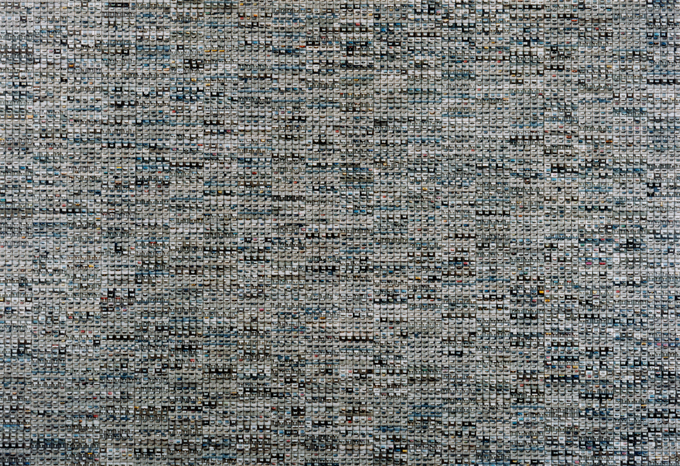Aren’t photographs taken to illustrate something? Going against this tradition, photographer Hong-chun Park says that he prevents viewers from finding specific images.
The exhibition in the Gallery Ihn. There are three large-scale works measuring 4m by 3m or 3m by 4m. At first glance, the images presented do not make sense to my eyes.
The works are large collages in which 10,000 film-sized cuts (3cm x 4cm) are put together. These large-scale works present 10,000 cars, 10,000 trees on the street, and 10,000 store entrances, respectively.
“The energy of Seoul itself is this work,” the artist said. He had to struggle to capture this energy. After he decided to take pictures of cars, trees on the street, and stores representing individuals in the city, he traveled through Seoul with his camera. Taking pictures of cars from the overpasses around Seoul, such as SeoDaeMun, JangAnDong, and JamSil, he was mistaken for a carparazzi. He shot 30 rolls of film of cars a day, then developed and cut them by hand. Just pasting the 10,000 cuts on the board required 15 days.
The 10,000 cars seem to represent the anonymity of the big city.
License plate numbers that differentiate each individual car like social security numbers differentiate humans can be seen when we look at the images through a magnifying glass, but otherwise it is hard to identify each individual car, and this is not important in the huge-scale work. It is only intended to illustrate that everyday lives of modern people are intertwined with each other’s and people are moving just like ants.
|
|
The same goes for the Apartment series, which appears on another wall in the exhibition. While points on the photography look like the twinkle of stars in the universe, a closer look reveals that they are apartment lights captured from a distance at night. To produce this photography, composed of 1,225 cuts, Park took pictures of 1,225 apartments as he combed through the apartment complexes around Seoul. The works are full of a sense of desolation, which seems to suggest that human beings are as evanescent as cosmic dust although we claim that ‘this is my house’ through the numbering of our apartments.
Also, images are created through the extended exposure. When Park leaves his lens open for 30 minutes in a crowded place such as an amusement park or zoo, moving objects disappear and only the stationary elements remain, which creates an eerie atmosphere. The works make viewers feel the fear of being left alone or the anxiety of a recurring non-realistic nightmare. “I intended to capture the passage of time and erased people because of skepticism about the city civilization,” said the artist.
Park has already completed taking pictures of 10,000 trees on the streets of Tokyo and Sydney. Continuing this “10,000 Cuts City Series,” he is taking pictures of his father these days.
“When I visit my father in GwangJu four or five times a year, I shoot 10 rolls of film of his close-up portrait. It will take another several years to complete 10,000 cuts,” said Park. “I hope that viewers think of their own father, not Park, HongChun’s father,” when they stand in front of the work, which will combine 10,000 cuts of his father’s portrait. When I asked what his father says about the project, Park answered that he is always most worried about the price of film.
From Apr. 25 through May 9 (82-2-732-4677)
- from The Chosunilbo, Apr. 23. 2003.
|
